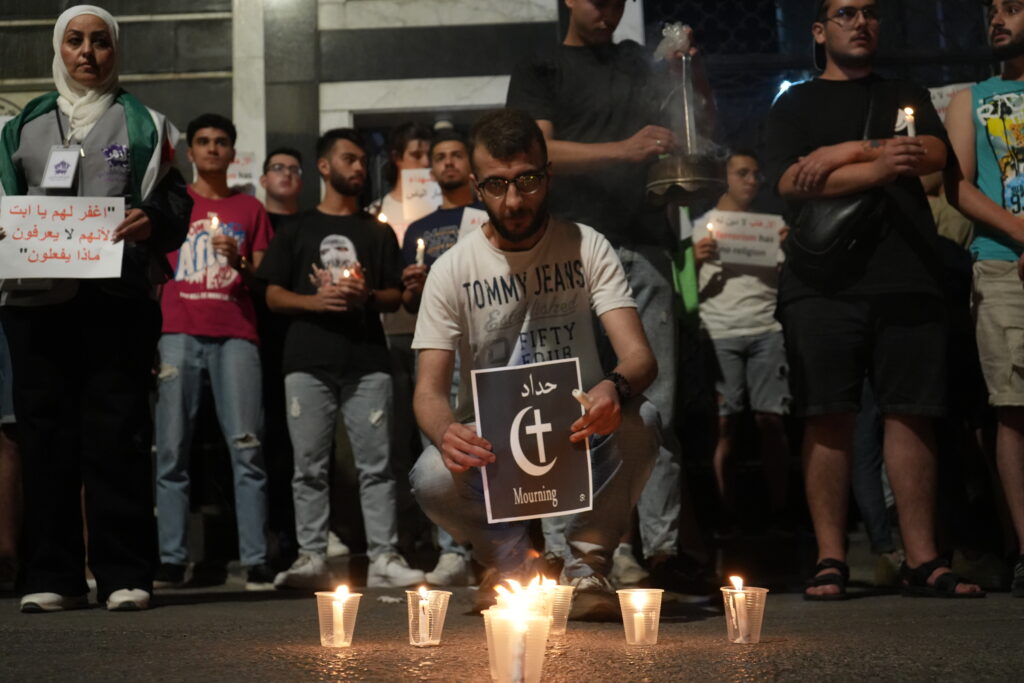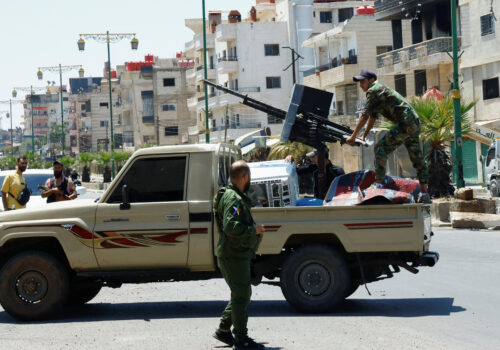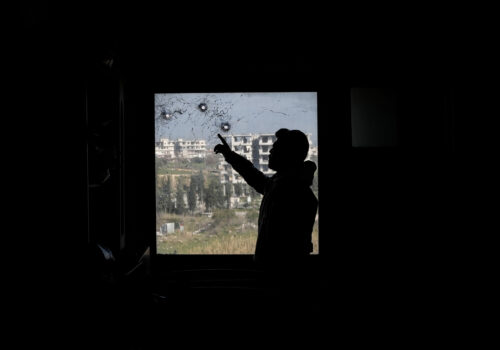On the morning of July 6, Christian parishioners in Syria’s small coastal city of Safita awoke to find death threats outside their churches. They were signed “Saraya Ansar Sunnah,” the same terrorist group that just two weeks earlier had claimed responsibility for the brutal suicide bombing of the Mar Elias Church in Damascus that killed 25 worshippers. The bombing brought the contentious state of Syria’s Christian community after the fall of Bashar al-Assad and ascendency of President Ahmed al-Sharaa, a former Islamist militant, to the foreground.
On the day the leaflets were found, I was in western Hama in the Christian town of Suqaylabiyah, meeting with government officials and priests. When asked about the leaflets, the head of the town’s Eastern Orthodox community, Father Dimitri, laughed, discounting them as a weak attempt by pro-Assad Alawite insurgents from the villages around Safita to capitalize on the fresh fears after the attack in Damascus.
Father Dimitri then pulled out his phone and called one of the priests in Safita whose church had been targeted.
“How is the situation, Father? What happened?” he asked.
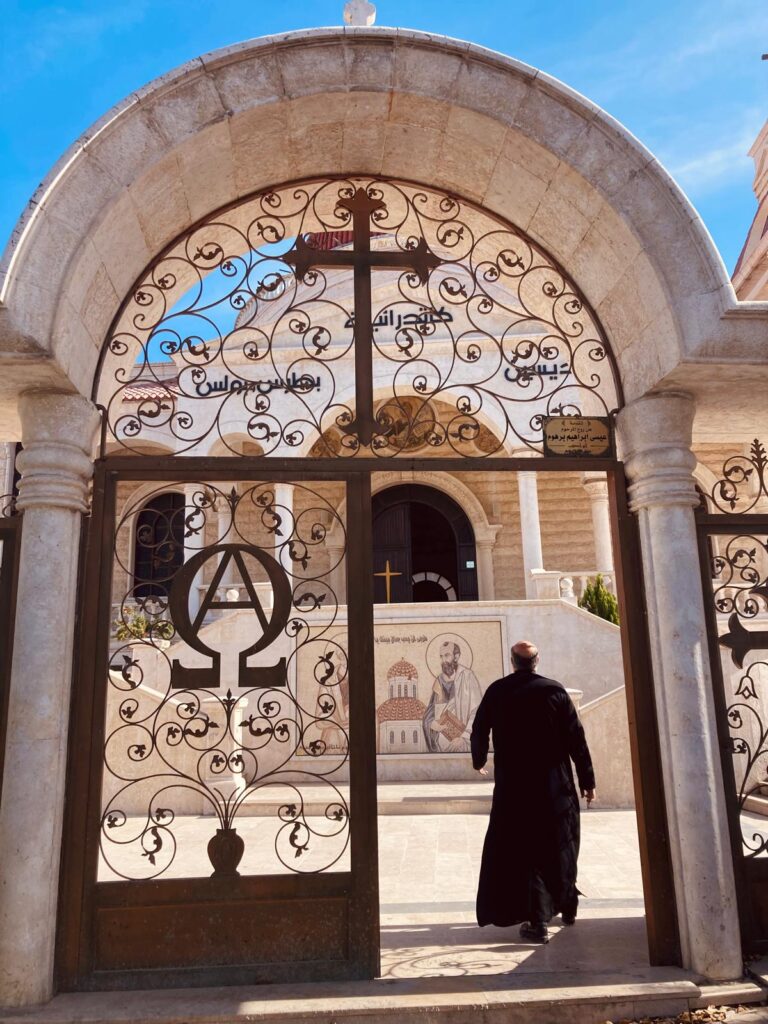
Like Dimitri, the Safita priest quickly dismissed the leaflets as a pro-Assad trick, insisting everything remained stable within the city.
Despite this bravado, the conditions of Christian communities across the country remain varied, and the opinions of religious and community leaders deeply mixed. In May and July, I visited Christian towns across western Syria, where I heard about their concerns for the future and their relationships with neighboring Sunni and Alawite communities. Responses spanned the entire spectrum, from complete rejection to passionate support for the new government.
The Sunni Angle
Suqaylabiyah was once known for its powerful Russian-backed pro-Assad militias. But the militia leaders are now widely believed to live in Moscow, having fled the country days before Assad himself.
With the militias gone, the new religious and civilian leaders in Suqalyabiyah cooperate closely with new Damascus-appointed officials. Here, a young Hayat Tahrir al-Sham (HTS) officer, Fayez Latouf, serves as the head of the broader administrative district. Within the town itself, a long-time Christian Free Syrian Army commander, Amjad Haddad, serves as the mayor. The town’s main commercial street remains open well after midnight with young people sitting at cafes, drinking tea and alcohol.
When asked about the cultural freedoms of the town’s Christian population, one young woman explained to me that when Latouf first arrived, he considered limiting the town’s bars, but that the community simply went to him and stood their ground, demanding that he respect their culture and rights. According to both the woman and Father Dimitri, Fayez has since been extremely cooperative with the Christian social and religious leadership, fostering a safe environment in the city.
Father Dimitri believes Haddad is a significant reason for the speed with which his town accepted the new government and engaged in close cooperation with the new local authorities.
“We are lucky to have Amjad among us to explain how the Sunnis are and ease our initial fears,” he explains, citing Haddad’s more than ten years fighting alongside Sunni revolutionaries. When Haddad returned to Suqaylabiyah, he played a key trust-building role between the community and the new authorities.
Familiarity with Sunnis, or the lack thereof, appears to be an important factor in how Christians perceive the new government. In the city of Latakia, Christians and Sunnis have lived together for centuries. This historic proximity has resulted in close relationships between the two religious groups, even among otherwise deeply conservative Sunni fighters.
SIGN UP FOR THIS WEEK IN THE MIDEAST NEWSLETTER
Ali Hamada, for example, returned to his home in Latakia on December 8 of last year, twelve years after being exiled. He has been a long-time supporter of HTS, but upon his return, he quickly established an armed neighborhood watch group consisting of Christians and Sunnis protecting each other’s holy places during their respective holidays. In my conversation with him, Hamada is very open in his sectarian disdain of Alawites and Shia, but talks at length about the important social and religious ties between Sunnis and Christians.
One Christian activist in the city, Tony Daniel, echoes these sentiments. A political activist and ex-Assad detainee, Tony works with multi-sect civil society groups in the city and its countryside that aim to connect locals to the government and vice versa.
“Christian Syrians were a tool by the Assads,” he explains. “Most of us left Syria under the Assads, but many Christians are now afraid of this government because Assad told everyone that if Muslims take over, they will oppress you.”
This fear was a major obstacle that Tony and other activists worked on in those first weeks after December 8. He cites the new government’s quick engagement with Christian leaders across the country and their ability to ensure safe Easter celebrations as important milestones.
“The government protects us and we pray and dress how we want,” Tony says.
But, he adds, “Christians are afraid of the constitution now.”
While Tony does not believe the new government will persecute Christians, he cites the lack of democratic safeguards in the March constitutional declaration as a significant problem. “When I see and hear [al-Sharaa] talk, it is beautiful words, I trust [al-Sharaa] and most of the government, but when I see this constitution and the way some militias act it is not the same.”
Based on my visit to these areas, this lack of trust in the new government is much more pronounced in the Christian communities that are more isolated from Sunnis. The towns of Mashta Hilou and Wadi Ayoun, located just east of Safita and surrounded by Alawite villages themselves, are prime examples of this dynamic. Here, Christian priests and civil society activists are much more cautious about the new government and fear that Sunni religious figures are taking too much power.
“We get our news from social media,” explains a doctor and influential community leader in Mashta Hilou in May. “This has caused a lot of frustration within our community and the spread of false news.”
He cites a lack of clarity on new laws and an increase in petty crime, all resulting in a deepening distrust of local security officials. This animosity has only grown as the officials responsible for Mashta Hilou continue to sideline Christian civil society organizations, hardening the barriers between the government and locals.
This dynamic stands in stark contrast to Suqaylabiyah and Latakia, where local officials have engaged extensively with Christians and, as a result, have assuaged many of their fears. Without this, those in Mashta Hilou are left to draw their own conclusions.
“I see what ISIS [the Islamic State of Iraq and al-Sham] did to Christians in Iraq,” says the doctor, “and so I make an assumption given Sharaa’s background, and the lack of implementation of his promises.” Misinformation and false claims on Facebook about new government policies rooted in Islamic law have all fueled a belief that Damascus will soon impose Sharia law upon the country.
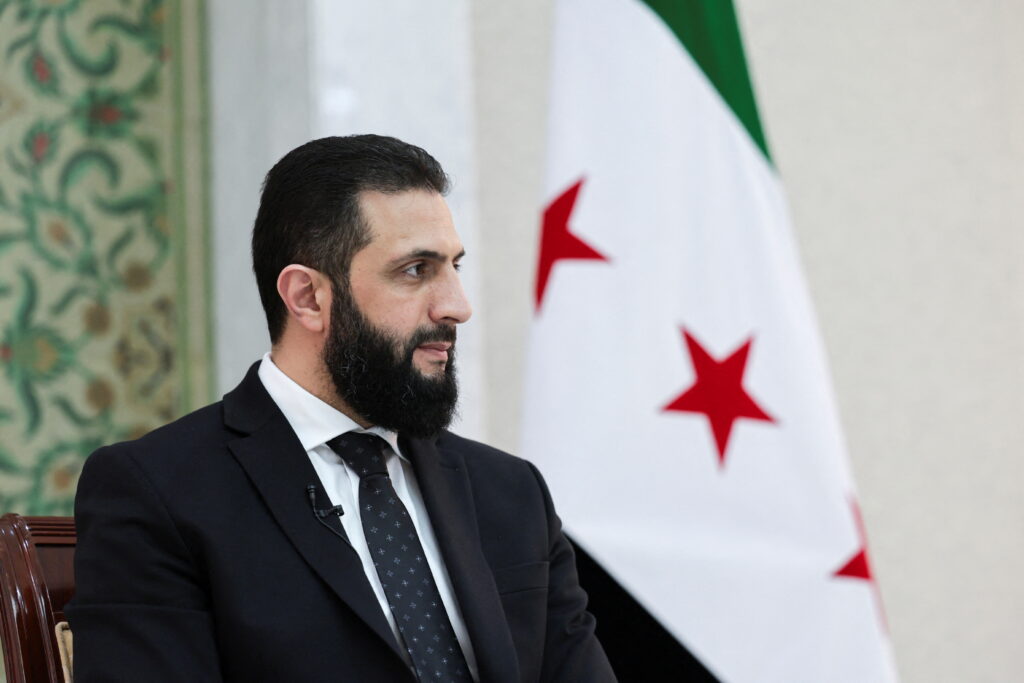
As one priest in Mashta Hilou puts it, “if Sharia Law is implemented, then Christians will be immediately discriminated against.” Like the doctor, the priest also cites al-Sharaa’s “history in ISIS” as a cause for concern. Al-Sharaa was originally a member of al-Qaeda in Iraq, the predecessor of ISIS, but he explicitly rejected merging his Syrian group with ISIS in 2013.
“We are more comfortable around Alawites,” the priest admits, “because even though they were raised on shabiha [Syrian term for pro-Assad thugs] behavior, they are not religious.”
The behavior of some religious extremists among the government’s rank and file fuels these concerns. Several Christians on the coast cited instances of harassment by soldiers for wearing a cross, or wounded fighters who refused to be treated by female nurses.
The head priest of Wadi Ayoun says much the same—otherwise quelled fears “renewed” after March 6.
However, the decrease in violence in the region since March and the reopening of roads to other parts of Tartous and Homs have helped reduce local fears once again.
“The government must ensure our genuine safety,” the priest says, “protect everyone’s rights and create a civil state.”
Unclear security threats
Until the June 22 attack in Damascus, these security fears were largely rooted in distrust over the new government’s militant Islamist background and the violations being committed against Alawites. These fears were generally more common in communities with poorly performing local officials or those that were isolated from other Sunnis. Even amid their hesitations and criticisms of the new government, everyone interviewed in Mashta Hilou and Wadi Ayoun in May admitted that the security situation was very good at present.
Yet, minor incidents have occurred occasionally across the country, underlying the threat posed by armed extremist Sunnis operating outside of the government. On December 18, armed men shot at a church in Hama. Five days later, a Christmas tree in Suqaylabiyah was burned by a foreign fighter. On February 17, a group of youth destroyed crosses in a cemetery in rural Homs. On April 6, assailants attempted to burn down a church in Damascus. On May 17, the car of a Christian family in Hama city was burned, and threatening leaflets were left in the area. On June 8, a church in Homs city was shot at.
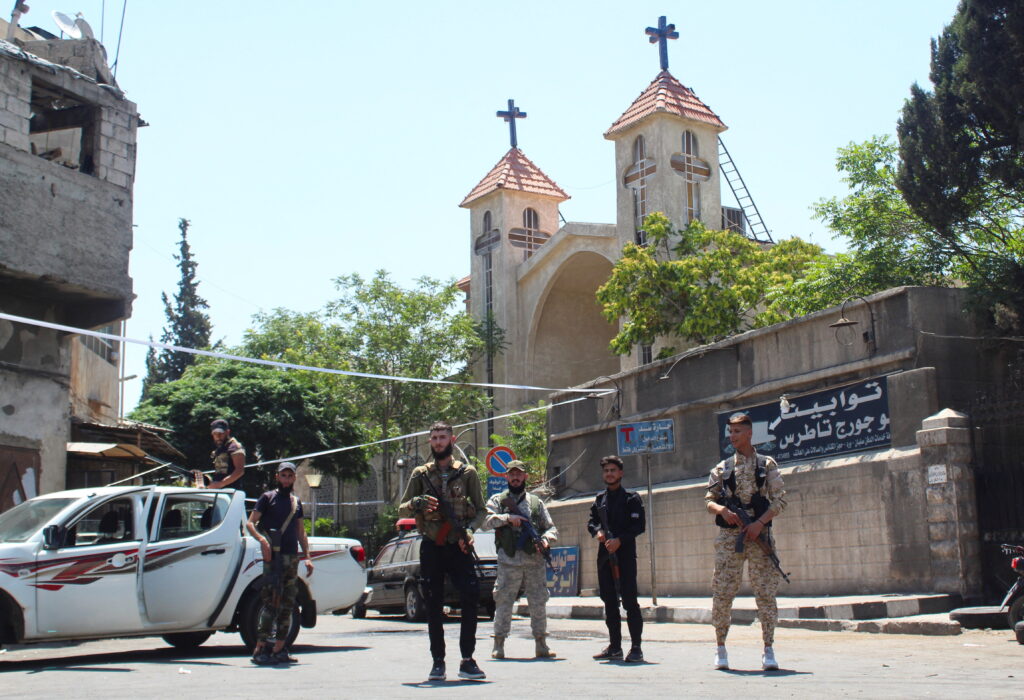
But it was the June 22 terror attack in Damascus that truly shook Syria’s Christians. Even a month later, Suqaylabiyah’s Father Dimitri admitted that his congregation is only now beginning to return to Sunday services. “We have reached a very good place in this area and deal with the government and security forces easily, thanks to their engagement with our religious and civilian leaders.” Nonetheless, the Father says that the bombing caused widespread anger and fear in the town that he and other leaders are still struggling to address.
For some Christians, the Damascus bombing played no role in their opinions—they had already given up on the new government. When asked about local governance, a couple who live in a small village just outside Tartous city engaged in a multi-hour tirade against the new authorities, blaming them for everything from the lack of functioning water lines to what they perceived as an “Islamification of coastal Sunnis, citing some Sunni friends’ adoption of the hijab.
While they deny that any Christians have been harassed in their area, they are terrified that this calm will change at any moment. At the same time, their village has rejected any General Security deployment within it, and they claim that even if there were Christian security members, “they would still be instructed to harass us.”
Complex dynamics in Idlib
Perhaps the most complex Christian dynamics exist in Idlib, where the small number of Christian families remaining in six villages along the governorate’s western edge have had a complicated, evolving relationship with the new authorities. These villages were first freed from the regime in late 2012 by neighboring Free Syrian Army factions, whose leaders quickly engaged in dialogues with the local priests. Yet the situation deteriorated over the ensuing years, with criminal FSA-affiliated and Islamist gangs robbing and kidnapping locals amid regime airstrikes. In 2014, ISIS briefly captured the region from the Syrian opposition. According to one local priest, the terror group quickly put an end to the random crimes through their excessively violent punishment of thieves, but also heavily limited their religious freedoms. Crosses were not allowed to be displayed, church bells could not be rung, and women were required to wear headscarves.
None of this changed when ISIS was evicted in 2015 and Jabhat al-Nusra—the predecessor to HTS—took charge. It would not be until 2018 when the HTS-affiliated Syrian Salvation Government was formed that HTS leaders began to address these years of violations. By now, most of the people in the six villages had fled to Europe or regime-held areas, and a variety of foreign and Syrian fighters had seized most houses and lands. Al-Sharaa’s chief religious official, Sheikh Abdul Rahman Atoun, who now serves as the head of Syria’s Supreme Fatwa Council, began to personally engage with Father Hanna Jalouf, who was later named Bishop and vicar of Aleppo by the Vatican.
Years of dialogue saw the gradual return of homes and property first to those Christians who still resided in Idlib, and then to caretakers within the community for the property of those who had fled. In late 2022, Atoun finally issued a fatwa legalizing public religious practices for Christians. By this point, HTS had greatly improved security in the area, eliminating violent threats against Christians. As Jalouf told me in a meeting in Idlib that year, significant progress had been made in their inter-faith relations, with some property disputes being the only remaining issues.
By July 2025, these property disputes were still not fully resolved. Almost all homes in five of the villages have been returned, but in one village, Yacoubiyah, many homes are still occupied. Meanwhile, in the three Christian villages on the edge of the Hama plains, most of the farmland remains under the control of the Uyghur foreign fighter group Turkistan Islamic Party (TIP).
As with the Christian communities elsewhere, priests and locals in these villages paint a complicated picture of their current situation.
“There is a huge difference in the amount of freedom here and other parts of Syria,” says one elderly woman in Judayda as she described their more socially oppressive environment.
“Only two foreign families remain in our village—without permission, or paying rent. They have not caused issues, but no Christian will go close to them out of fear. Last week, a woman and her husband were walking on the street without a headscarf, and someone from the [foreign] family spat in their face. It was just a family member, not a fighter.”
In Qunaya, the village’s priest emphasizes the danger these foreign fighters pose to the community.
“We don’t speak with these families occupying our houses,” he said in July. “We just work through the government, as we did before December.”
He says all the farmland in this area has been returned to the Christian families, and believes the authorities will soon return the last stolen homes. He adds that although the community has a good relationship with the officials in Idlib and Damascus, “it just takes time because they are trying to remove these people without using force.”
Despite this, both the priest and the woman from Judayda insist that the security situation in their areas is good, differentiating between the harassment from locals and the treatment of the authorities. “Here in Idlib we are very safe and don’t have these kinds of attacks targeting our churches,” they say, highlight the trust that has grown over the years between their community and HTS’s security services.
“After the attack in Damascus, we were mentally exhausted,” the woman says. “We were afraid of going to the churches, but we still went because the General Security is guarding them.”
Stuck in the middle
For some Christians, the violence that has persisted in the shadow of Assad destroyed any opportunity for their trust in the government. The March 6 insurgent uprising on the coast and the subsequent massacre of Alawite civilians by armed Sunnis and government forces shattered the cautious optimism in the brief period of relative peace following the fall of Assad.
One activist in the city of Baniyas had been optimistic for his country’s future, despite the sectarian challenges, before March 6. “No matter what, Syria is my country, I will send my children away for a better life, but I will never leave,” he said defiantly in February.
But the brutality of the March 6 massacres broke any confidence he had that Damascus could contain the sectarian violence left in Assad’s wake. “I don’t care anymore,” he said in May, “I am doing everything I can to leave this country.”
In other places, Christian leaders have taken on a mediation role, doing their best to lower tensions. In Suqaylabiyah and Latakia, for example, Christian priests and activists have begun serving as mediators for Alawites from the countryside, utilizing their close connections to local officials. In return, they try to show their Alawite neighbors that minorities can work with the new government, slowly building trust between the two sides.
One fact is clear: there is no one Syrian Christian experience. Like every Syrian community, some Christians are fearful, others optimistic, and some have lost all hope. While it is clear there is no systematic targeting of Christians by the new government at large, Damascus still has a long path towards earning the whole community’s trust.
Gregory Waters is a researcher at the Syrian Archive and an independent analyst whose research focuses on the development and reform of security institutions, local governance initiatives, and sectarian relations.
Further reading
Wed, Jul 30, 2025
After Swaida: How Syria’s periphery is shaping its future
MENASource By Ibrahim Al-Assil
What comes next in Syria will not be determined by battlefield victories or summit declarations, but by the evolving realities on the ground.
Wed, May 28, 2025
Sectarianism, social media, and Syria’s information blackhole
MENASource By
Since Assad’s December ousting, Syrians have struggled to sift the truth from fake claims about security incidents across the country.
Fri, Aug 8, 2025
Sweida’s humanitarian crisis presents a test for Syria’s transitional government and its global partners
MENASource By Diana Rayes
Sweida is not an isolated tragedy—it is a litmus test for Syria's fragile political transition and for the international community’s resolve to respond to the unfolding humanitarian crisis.
Image: Syrian Christians hold a protest in front of the Umm al-Zannar Church in Homs Governorate, central Syria, against the backdrop of the suicide bombing that took place at the Mar Elias Church in Damascus, which left more than twenty dead and 52 injured, according to the preliminary toll of the bombing.
